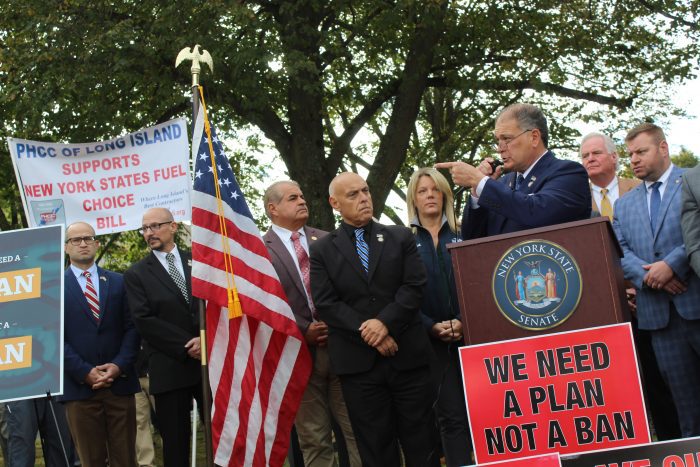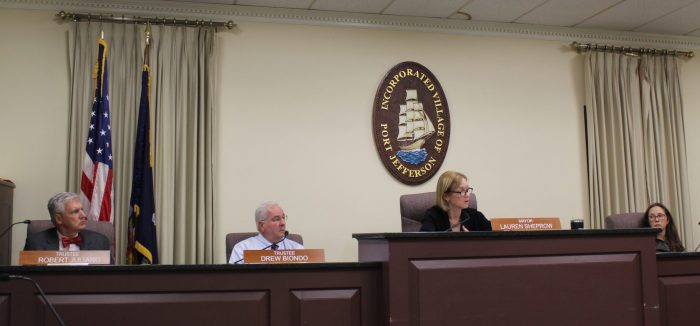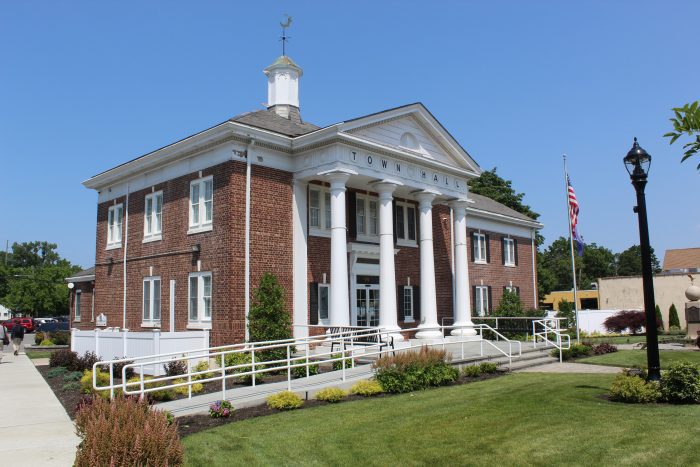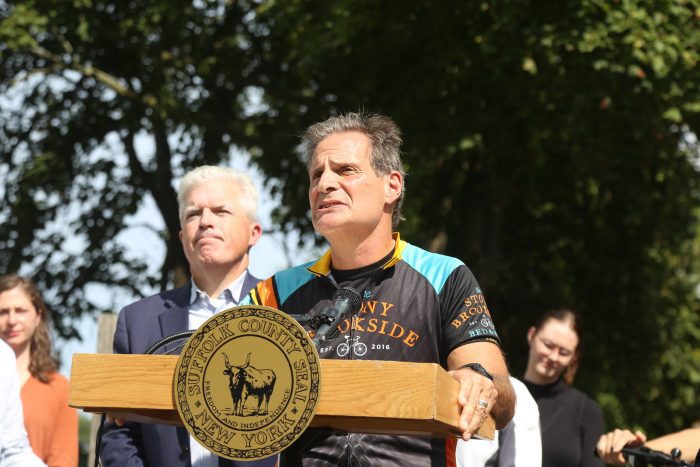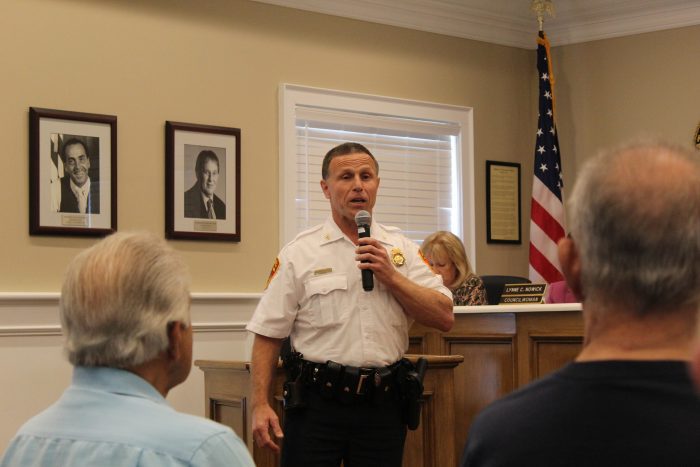Major party candidates for three local offices went before the public Tuesday evening, Sept. 26, for a Meet the Candidates forum at the Comsewogue Public Library hosted by the Port Jefferson Station/Terryville Civic Association.
Brookhaven Town Council
Vying for Brookhaven’s 1st Council District, which encompasses Port Jeff Station/Terryville, incumbent Councilmember Jonathan Kornreich (D-Stony Brook) is defending his seat against Republican Party challenger Gary Bodenburg, a special education teacher at South Huntington School District.
Kornreich was first elected to the Town Board in 2021 following a special election for the vacated seat of former Councilwoman Valerie Cartright (D-Port Jefferson Station).
Kornreich served on the Three Village Central School District Board of Education and as president of the Three Village Civic Association. His professional background is in construction and real estate finance.
“I understand the economics of what drives boom and bust cycles, and how to evaluate our current stock of real estate and what can make a project viable,” he said.
Bodenburg, along with his role as an educator, has conducted local advocacy work for at-risk youth, serving on several committees within the Comsewogue School District.
“I have always been somebody that is willing to help and put my hat in the ring with anything that goes on in our community, and I’m looking forward to expressing that in this capacity as well,” he said.
On land use, Bodenburg objected to the trend of developing new apartment complexes in and around PJS/T.
“I do believe there’s a need for housing,” he said. “Once I’m able to get involved in it and I can see a little deeper, a little clearer, it makes it a lot easier.”
Kornreich said the board needs to incentivize redevelopment, citing mixed-use development as a potential means for making redevelopment economically viable.
“If it were up to me, we wouldn’t add any new residences — I think we’re already at our carrying capacity,” the councilmember said. “We all know traffic is a nightmare, but in order to revitalize these areas, we have to be able to make it work financially for the developers.”
Given some local concerns over traffic impacts from new developments along the Route 112 corridor, Kornreich supported commissioning a comprehensive traffic study to assess interactions between proposed developments.
He warned against the trend of privately commissioned impact assessments. “I think at the town, we have to stop allowing people to just hire their own experts to tell [us] what they’re being paid to say,” the incumbent said.
Bodenburg acknowledged the value of impact assessments, though he warned against studying at the expense of progress.
“I think we need to fully evaluate anything that we’re doing, but there does come a point in time where we can’t continue to just study things and we have to make actual action,” he advised.
When pressed on growing density pressures within the hamlet, Bodenburg said he has been coordinating with a real estate developer and revitalizer interested in working with the town to develop properties and expand affordable housing opportunities for residents.
“We have to be a little more creative than we have been in the past, and I think that that is something that we need to look into,” he said.
Kornreich said the region offers limited residential opportunities for young families with an “insatiable” demand for affordable housing.
“The way that we can address this at the town level is pretty straightforward,” he said. “We have control over local zoning … so we could offer incentives to developers who are going to put affordable units in their development.”
But, he added, “For these projects to work, that’s where we need the state and federal government to do things like providing low-interest loans.”
Suffolk County Legislature
Former New York State Assemblyman Steve Englebright (D-Setauket) and former NY-1 congressional candidate Anthony Figliola (R-East Setauket) have both stepped forward to fill the now-vacant 5th District seat of former Suffolk County Legislator Kara Hahn (D-Setauket).
Figliola, whose professional background is in government relations with related advocacy work for the proposed electrification of the Port Jeff Branch line of the Long Island Rail Road, centered much of his platform around the electrification initiative.
Electrification would cause “less particulates going into the atmosphere,” he said. “Also for economic development, with the revitalization of Port Jefferson Station and all the [stations] along that from St. James all the way to Huntington.”
Englebright served in the county Legislature from 1983-92 and the state Assembly from 1992-2022. A geologist by training, he concentrated his platform around green energy and environmental protection.
“I sponsored most of the laws that set the stage for the creation of a renewable energy program for the state,” the former assemblyman said. “Green energy initiatives are critically important for our future.”
When asked about the future of the Lawrence Aviation Superfund site in Port Jeff Station, Englebright endorsed the idea of relocating the existing rail yard to the property while eliminating the grade crossing on Route 112.
“The whole idea of having a rail yard there and getting rid of the at-grade crossing on 112 is very much with the concept of having a workable and safe environment,” he added.
Figliola said the community is currently on a path toward a renaissance with the site’s eventual redevelopment. He emphasized the need for public input as these local transformations continue.
“Whatever happens, the community needs to be a part of it,” he said. “As your legislator, I will certainly take the lead in working with all the various agencies to ensure that your voice is heard.”
This year’s election comes amid a countywide debate over wastewater infrastructure. When asked about the Republican majority’s recent decision to block the advancement of the Suffolk County Water Quality Restoration Act from reaching the November ballot, Figliola advocated for more sewer infrastructure.
“I am absolutely for finding dollars where available,” he said, adding, “If the voters so choose that they want to have an extra tax, that’s something that I would be for in the Legislature — for the voters to make that decision.”
Englebright objected to the Legislature’s reversal on wastewater, saying it jeopardizes tourism and agriculture, the county’s two largest industries.
“I do not believe that at the last minute — at the 11th hour — this initiative should not have been given to the public,” he said.
Town supervisor
In a race to succeed outgoing Town of Brookhaven Supervisor Ed Romaine (R) — who is running against businessman Dave Calone (D) for Suffolk County executive — Deputy Supervisor Dan Panico (R-Manorville) is squaring off against SUNY Old Westbury adjunct professor Lillian Clayman.
Panico was a practicing attorney and served as senior deputy Suffolk County clerk before entering town government. He served on the Brookhaven Planning Board before his election in 2010 as councilman for the 6th Council District, an office he has held ever since.
Clayman is a Port Jefferson resident who served three terms as mayor of Hamden, Connecticut, before becoming an organizer for health care union 1199SEIU United Healthcare Workers East and later as chair of the Brookhaven Town Democratic Committee. She currently teaches labor and industrial relations.
Clayman indicated that effective public administration starts with proper personnel decisions. “I surround myself with people who I think are smarter than I am,” she noted.
To streamline the town’s existing administrative structure, she proposed revamping the Building Department, citing voluminous paperwork and other complications within the permitting process.
While Panico referred to himself as “very similar to Supervisor Romaine,” he suggested some differences in administrative approach.
He proposed staffing his administration with “people who want to work, people who care about their jobs, no one looking to clock time or [collect a] pension and people who are honest.”
Each candidate was questioned on how his or her administration would handle the impending closure of the Brookhaven Town Landfill, located on Horseblock Road, and the precipitating loss of public revenue for the town budget.
Panico supported a more aggressive recycling campaign with greater pressure on the New York State Department of Environmental Conservation for regional sustainable planning.
“What we need to do is enhance recycling and get the DEC to go forward with a comprehensive plan to promote markets for recycling,” he said.
While acknowledging that land use is the primary function of the town government, Clayman said the town has a secondary responsibility to promote environmental protection.
“Brookhaven is supposed to protect the air that we breathe,” she said. “Brookhaven is supposed to protect the people who live around the landfill, who have since 1974 been living with that garbage.”
She added that expanding composting activities within the town would reduce the waste volume entering the landfill.
Voters will decide on these candidates in just over a month: Election Day is Tuesday, Nov. 7.

